Thanks to “Life by Design” in Caribou, Maine
On Friday, December 13 I had the grand pleasure of presenting to this great workgroup.
(BTW: Best I can tell, their leader, Deb, is the person we would all love to be working for.)
Here is a quick review of the day:
The Psychological Flexibility Model and Creating the Life You Want to Live
We started off with what is known as “The Psychological Flexibility Warmup” or “The first Loop around the Matrix”
This first Loop focuses on the individual within the workgroup. To share this point of view with others (and that’s the best way to learn) you draw a vertical line and put 5 senses at the top and mental at the bottom like this:
and then notice the difference between 5-senses and mental experiencing.
Next we add the horizontal line…Recall moving Toward someone who is important to you. Now recall moving Away from some unwanted internal experience like Fear.
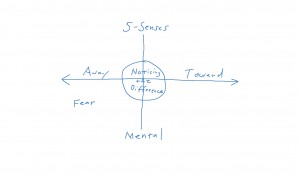
Noticing the Difference between how it feels to move Toward who’s important and how it feels to move Away from uncomfortable mental experiencing like Fear.
and then notice the difference between how it feels to move toward an important person in your life and how it feels to move away from some unpleasant mental experiencing like fear.
Then we did the four questions:
Who’s important to you? (lower right quadrant)
What shows up inside of you (like Fear) and gets in the way of moving Toward who’s important. (lower left)
What behaviors do you do to move away from unwanted internal stuff, such as running to move away from fear? (upper left)
What behaviors could you do to move Toward who’s important to you? (upper right)
And then we did the “Second Loop” around the Matrix for the workgroup:
1) Notice (using the appropriate 5-senses) one or more of your co-workers. We went through each of the five senses, leaving off taste (tee hee).
2) Then we experienced our coworkers in our minds. There we could use all of our five senses all that we want (more tee heeing).
3) Then we noticed the difference between five senses and mental experiencing of coworkers.
4) Then we recalled moving Toward coworkers.
5) Then recalled moving Away from unwanted feelings regarding coworkers.
6) Then we Noticed the Difference between how it feels to recall moving Toward coworkers vs. moving Away from unwanted feelings related to coworkers.
7) Then came the four questions, but this time for the workgroup:
a) What shared purposes does this workgroup want to move toward?
b) What kind of stuff shows and gets in the way of moving toward the shared purpose?
c) What kind of behaviors do coworkers do to move Away from the uncomfortable stuff that shows up inside?
d) What kind of behaviors could all the coworkers do to move Toward the shared purpose of the workgroup?
Then Deb came to the whiteboard at the front to the room and did a Psychological Flexibility Warmup (Loop 1) with the group. Then another member of the workgroup (sorry, I forget her name) came up and also did the “Warmup.”
After the break we broke up into small groups and using PostIt easel paper everyone practiced showing each other the Psychological Flexibility Warmup. (Again, the best way to learn the Psychological Flexibility Point of View is to show it to others.)
Then right before lunch I presented the rather boring, yet important stuff about Positive Reinforcement (R+) on the Toward side, Negative Reinforcement (R-) on the Away side and then a bit about Relational Frame Theory (RFT). From a baby who is almost totally Sensory we learn to transform experiences onto sounds we can make called language. Humans are very, very good at language. So much so that we can start living life more in our minds (lower part of the Matrix) than in the 5-Senses, and this puts us at risk for getting Stuck in a special kind of Away loops (R-). For example, we might try to get rid of mental experiencing (like anxiety) that’s part of life. The more we try not to have anxiety, the more we have it. This vicious circle can eat up a lot of time and energy. I showed the workgroup the cover of Steve Hayes’ book Get Out of Your Mind and Into Your Life as an example of moving out of over processing life in the mind and using more of the five senses experiencing to learn from worldly experiencing. This “Sweet Spot” is represented by the circle at he center of the Matrix diagram.
Then we discussed how even the information needed for a 15-page care plan can be gathered using the Matrix diagram and it’s four quadrants.
Lunch: Fabulous food was brought in; these folks know how to do a party!
Right after lunch I answered a question from someone who had created a “personal goal and stress management matrix” and wanted to know about implementing it. I explained that while planning is very important in life, there’s a lot of life that just shows up and we need to be ready to create the life we want by flexibly responding with an Away or a Toward move in the moment. If we carefully notice the consequences of our actions, then we will learn through experience what is working to create the life we want. The visual metaphor is focusing on the center of the matrix where the lines cross after you have practiced noticing the two differences and have a good awareness of the four quadrants. By focusing on psychological flexibility in the center and keeping the other stuff in awareness, but in the periphery, you have the best chance of doing the planned behaviors AND responding in creative ways that might just work for creating the life you would like to live.
Then we did a “Bus” exercise. One person played the “Driver”, who identified an aspect of ‘Creating the Life You Want.’ Our driver chose “Health.” She then chose Walking as a behavior that could move her toward health. She then identified several “Passengers” who might show up inside of her and get in the way. She asked and directed a different coworker about how to playact the passenger inside of her head. She also identified and directed a couple of motivational passengers. Eventually, after much hilarity, it became clear that having a collaborative, accepting relationship with the passengers was less taxing than having an adversarial relationship with the passengers. She then took all the passengers along for a walk.
After another break we discussed the two basic questions of ACT:
1) What is the life you would like to go about creating for yourself?
2) What shows up and gets in the way?
We did some role playing about how to use words (and the matrix) to change the context that a behavior occurs within rather than trying to directly change the behavior. For example:
15 year old son says, “I want to be the best Grand Theft Auto (video game) player in the world!”
One possible response: “You are not allowed to play that game, period.” (Probably leading to the response of more playing of the game.)
Yes…And response: “Great! Once you are the world’s best Grand Theft Auto player, how will you next go about creating the life you want?”
We discussed how the first few words of an encounter sets the context for the following behaviors, so choose collaborative, affirming words as best you can.
We discussed that when working with others, showing the Psychological Flexibility Point of view (e.g., Matrix diagram) sets this collaborative, affirming context, so show it soon after you begin to work with someone.
Noticing Hooks and What You Do Next “Homework”
1) We all get hooked by people cutting us off in traffic, saying unkind words, seeing a beautiful person, etc. A ‘hook’ is one of these events that keeps churning inside of us for several minutes or more.
2) Do you think you will have the opportunity to notice a hook in the next year? How about in the next six months? How about three months? Then someone said, “Probably in the next ten minutes!”
3) Great! Next time you might notice the hook and what you do next. (Note: the purpose of what you do next is not important. Simply note the behavior you do next, e.g., walk, talk, sit, stand, etc.)
4) You can either do or not do this homework, both work equally well for learning.
The basic idea of the Psychological Flexibility Point of View is that almost every human has the ability to go about learning and creating the life they want to live. The problem is that the mind often shows up and gets in the way of learning.
The Matrix, combined with collaborative, affirming words usually results in Curiosity showing up. While using the psychological flexibility point of view we have a great curiosity about what the other person is saying. The Noticing Hooks homework (you can do it or not do the homework, both work equally well) sets up this curious stance and increasing the chances of creating the life you want to live.
Questions:
How might the Matrix be used with couples?
First have each member of the couple do a personal (and private) matrix.
Next have the couple work together and create a “Couples” matrix.
Someone added: You could do a whole family, each member fills out a personal, private matrix, then the family comes together to fill out a family matrix. Of course, mom and dad always have their combined “Couple” matrix.
Relationship Relationship
We discussed that it all boils down to having curious and collaborative relationships with our minds and others.
Caribou Folks: If I forgot something, please add it as a comment to this blog, or email me and I will add it.
Thanks so much for a great day.
Sincerely,
Kevin

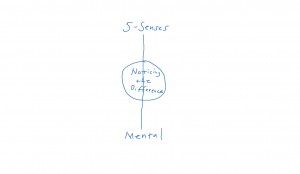
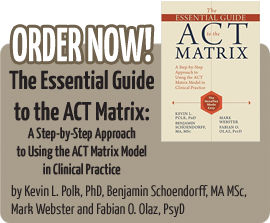
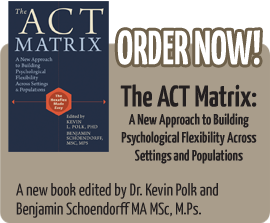
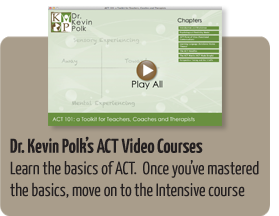
Leave a Reply